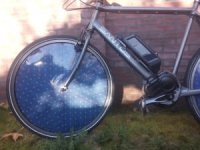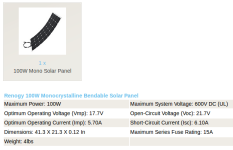could you state what equipment your using, maybe giving us links. what you used and what didn't work. not trying to be judgemental but if you say so and so regulator went bad on because of this set up this could save other posters some heartaches with your knowledge and other posters will give you their experience so this can help you. that would be helpful. you said solar regulator..name brand, specs maybe cost,link to it etc. that would be helpful for this topic. also you mentioned 100 ah batteries and never specified how you could make this mobile. it is a variation of the original posters idea 2, which I think is cool, and I also think your idea is cool too. i.e. you might want to start a thread on syntax, you have mentioned it several times. also you mentioned you sold agm batteries and solar setup very cool, send me a link to the forsale area of this forum and someone might be interested in purchasing something from you because of your technical background and overall charming personality.
Details about Solar Panel Charge Controller Control Regulator 10A 12V 24V CE Certify
9 bucks
http://www.ebay.com/itm/Solar-Panel-Charge-Controller-Control-Regulator-10A-12V-24V-CE-Certify/111372080556?rt=nc
Brand new and high quality
Protection function: overload, short circuit, low voltage, lightning and overcharge protection
Color: black
Dimension: Approx. 10.3x9.5x4cm
Output voltage: DC 12/24V ( Automatically identify )
Current: 10A ( rated charging current )
Working temperature: -20°C ~ +60°C
Power supply stop voltage: 10.8V or 21.6V
Power supply recovery voltage: 11.8V or 23.6V
Charging stop voltage: 14V or 28V
Stop charging temperature coefficient: -3mV / ° C / cell
Package included
1 X CMP solar panel charge controller
DC to DC converter 100W Boost power supply Regulator Volt Amp meter usb output http://www.ebay.com/itm/DC-to-DC-converter-100W-Boost-power-supply-Regulator-Volt-Amp-meter-usb-output-/291273499330?pt=LH_DefaultDomain_0&hash=item43d140e2c2
20 bucks
DC to DC converter 100W Constant voltage and current Boost power supply module step up Voltage Regulator with Voltmeter ammeter usb output for Charging #1300205
Boost Constant voltage and current,
With voltage, current display,
Output with USB port With identification resistor,
Single lithium battery can be directly rise to 5V to charge the phone. Large output current 2.5A.
Module parameters:
Module Name: 100W boost constant current module
Module Properties: non-isolated step-up module (BOOST)
Input voltage: DC 3-35V (limit of 36V)
Input Current: 10A (MAX) ,Please enhance heat dissipation exceed 6A
Quiescent Current: 15mA excluding voltmeter current (12V rise 20V, the output voltage is higher quiescent current will increase)
Output voltage: DC 3-35V continuously adjustable
Output Current: 6A MAX ,exceed 5A Please enhance heat dissipation
Constant current range :0.1-10A
Output power: = Input voltage * 6A, such as: Input 3.8V * 6A = 22.8W, 5V * 6A = 30W,
12V * 6A = 72W, input 24V * 6A = 144W,
Operating temperature: -40 to +85 ° C (ambient temperature is too high, please enhance heat dissipation)
Operating Frequency: 280KHz
Conversion efficiency: max 96%
Over current protection: Yes (input exceeds 12A, automatically reduces the output voltage, have a range of error.)
Short circuit protection: (input 15A fuse) double circuit protection, use more secure.
input Reverse Polarity Protection: None, (if required in the input string into the diode)
Output preventionanti-irrigation: Yes, for charging plus blocking diode is not required.
identification resistor: Tablet PC, pad, phone (some phones identification circuit is different, need to be adjusted)
voltmeter minimum resolution: 0.05V/0.05A (10V following automatic switching decimal point)
Installation: 4 pcs 3mm screws
Wiring: no need welding output terminals
Module dimensions: length 60mm x width 50mm x height 20mm
Applications:
1, DIY a power supply, input 12V, output can be 12-35V adjustable with voltage and current display,
2, the power for your electronic devices, can according to your system set output voltage value.
3, as the vehicle power supply for your laptop, PDA, or a variety of digital products supply.
4, DIY a laptop mobile power supply: 12V coupled with high-capacity lithium batteries,
5, the solar panel regulator.
6, DIY high current mobile power with a single lithium battery can be boosted to 5V, comes with USB port and identification resistor, and a large current of 2.5A output to several phones simultaneously charging.
Instructions:
1, the voltage meter power supply options: you can choose via jumpers voltmeter provided by the input supply or output is provided (IN table is an input, OUT is the output table) lower voltage can reduce the loss voltmeter, the jump lines jumpered to remove the jumper cap, voltmeter does not work.
2, USB output port: USB interface board is connected directly to the output terminal for 3V l 5V, can be directly used to charge the phone, has been identified with resistance to note is that in using the USB output, make sure the output voltage is the voltage with your digital product line, remember! ! Otherwise it will burn your digital products.
3, shows the voltage and current switching: This module via a band switch display input voltage and output voltage and output current, VI represents the input voltage, VO represents the output voltage. Represents the output current IO.
Output current adjustment method:
1, regulating CV potentiometer, According to your battery or LED, the output voltage is set to your desired voltage value. Such as 5-string LED voltage regulator 18.5V, 27.6V tune bunches batteries and so on.
2, set CC potentiometer counterclockwise around 30 laps, the output current is set to minimum, connect the LED, adjust CC China locator to the desired current. For battery charging, the battery is discharged, and then connected to the output, adjust to your desired current CC, (for sure when charging the battery completely discharged before being allowed to adjust, because the battery charge remaining in Vietnam more, the charge current is smaller.) Please do not use short-circuit current way of adjusting the boost module circuit structure can not short-circuit the way tune.
packing includidng :
1x 100W boost constant current module
12 Volt 26Ah Deep Cycle Rechargeable Replacement Battery Wheelchair 12v
60 bucks
This listing is for (1) 12 Volt 26 Amp Hour battery
Product Description
Amp Hour: 26
Voltage: 12
Termination: NUT & BOLT
Chemistry: SEALED LEAD ACID
Color: FLAME RETARDENT
Weight: 18.35
Width: 6.5500
Length: 6.90
Height: 5.00
solar panel----199
Condition:
New: A brand-new, unused, unopened, undamaged item in its original packaging (where packaging is ... Read moreabout the condition
Brand:
ECO-WORTHY
Ipm:
5.6A
Model:
100W folding solar panel
Isc:
6.18A
MPN:
FP100-1
Size:
1029*690*36mm
Country/Region of Manufacture:
China
cell marterials:
polycrystallline
Voc:
22.41V
Frame:
Heavy duty aluminum
Vpm:
17.9V
size(open):
1029*690*36mm
okay....solar panel to charge regulator....then agm battery hooked up..then load out to step up convertor to 44 volts...
would this blow up my 36 volt lithium????





